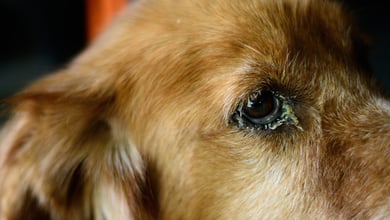Why are My Dog’s Eyes Red? 9 Possible Causes

Table of Contents
If you’re wondering why your dog’s eyes are red, there are a variety of potential causes. Most are easily treatable and not cause for alarm, but it’s always best to address any issues with your veterinarian just to be safe.
Red and itchy eyes can be very uncomfortable for our furry friends. A consultation with a veterinarian will help determine the source of their symptoms and begin a treatment plan as soon as possible. Just in case there’s anything wrong, prompt treatment will ensure that your dog’s symptoms don’t progress.
Here are the most common causes of eye redness in dogs:
1. Allergies
Just like humans, dogs can suffer from allergies to things in their environment like dust or pollen. This is the most common cause of red eyes in dogs, so typically there’s no cause for alarm if your dog isn’t exhibiting any other symptoms.
Signs of environmental or seasonal allergies include watery red eyes, itchiness, and sneezing, which can occur in spring, summer, or all year round.
The best way to address potential allergies in your dog is to schedule an allergy consultation with your veterinarian. At BetterVet, we can visit you and your dog at home to develop a treatment plan to relieve your pup’s symptoms.
Does Your Pet Have Itchy Paws or Flaky Skin?
Our veterinarians can bring relief. Schedule a visit for allergy testing in the comfort of your home.
2. Breed Susceptibility
Some types of dogs are more prone to red eyes than others. Pups with long fur, short faces, or wide eyes are more susceptible to eye issues because of the greater possibility of irritation and injury. This can include breeds like Pugs, Bulldogs, and Shih Tzus.
If your dog is more susceptible to eye issues due to breed, make sure to stay on top of their care. Consult with a veterinarian if your dog ever exhibits any symptoms including bloodshot eyes, inflammation, excessive scratching or itching, discharge, or eye swelling to ensure that the root cause can be identified and treated quickly.
3. Dry Eye Syndrome
Dry eyes, otherwise known as keratoconjunctivitis sicca, typically present as extreme dryness and inflammation. Normally your dog’s eyes become watery due to a moist membrane that protects their eyes. If they’re suffering from dry eyes, this protective layer isn’t there, which can cause your pup moderate to severe discomfort.
Dry eyes can be caused by malfunctioning tear glands that don’t produce enough moisture, immune disorders, chronic infections, or even certain medications can affect their ability to maintain the regular moisture around their eyes. Signs can include redness, dryness, discharge, and excessive itching.
4. Irritants or Objects in Eyes
Pups love to dig around, sniff, and play, and sometimes while doing so they’ll manage to get an irritant or object stuck in their eye. This can include dust, dirt, or larger objects like portions of plant matter.
Signs of your dog struggling with a foreign object stuck in their eye include acute redness and your dog showing symptoms of being in discomfort.
Consult a qualified veterinarian before attempting any treatment, as you may inadvertently scratch your dog’s eye or cause permanent damage if you attempt to remove it yourself.
5. Eye Injury or Trauma
Sometimes an object in the eye, an impact, or a scratch can cause a more severe injury to your pup’s eye. If a severe cut or scratch on your dog’s eye is left untreated it can lead to serious consequences, such as deep corneal ulcers, infections, blindness, and even loss of the eye entirely.
In the case of an eye injury, it’s extremely important to have your dog evaluated at an emergency clinic or animal hospital as soon as possible.
6. Conjunctivitis
Conjunctivitis, commonly known as pink eye, is an infection typically caused by exposure to some type of bacteria. Pink eye is usually easily identifiable because it typically only affects one eye, although the infection can later spread to your pup’s other eye.
Pink eye typically causes a bright red eye accompanied by itchiness, pain, and drainage from the eye that leads to crusting.
Pink eye is easily diagnosed at a veterinarian visit and is also easily treatable with medicated eye drops, although more severe infections may also require further medications for proper treatment.
Is Your Pet Feeling Under the Weather?
Get the care your pet needs without leaving home. We have same-day appointments in most locations when it can’t wait.
7. Scratched Cornea or Corneal Ulcer
Sometimes through regular play, scratching, and sniffing, your dog can end up scratching their cornea. Corneas are the membranes that protect the front of a dog’s eye. A scratch can cause discomfort and discharge, and your pup may also scratch or rub at their eyes, blink excessively, or squint.
Trauma to the cornea can also cause a corneal ulcer - an open sore in the front of your dog’s eye. They can also develop an ulcer from untreated dry eye as well as untreated bacterial or fungal infections.
Scratched corneas or corneal ulcers are treatable with veterinary care. Your veterinarian will likely prescribe medicated eye drops or other medications to treat secondary infections as well as medications to address any pain.
8. Gland Prolapse, or “Cherry Eye”
On occasion, a gland in your pup’s eye can prolapse, causing a condition known as cherry eye. This can be caused either by a genetic predisposition or by trauma to the eye area causing the gland to prolapse.
If your dog experiences cherry eye, they will have a visibly red or pink, fleshy swelling at the corner of their eye. Sometimes cherry eye can resolve on its own or with less invasive treatment, but typically surgical intervention is required.
9. Glaucoma
Glaucoma is typically caused by a buildup of pressure in the eye due to lack of fluid draining. It may also be caused by trauma, infections, or tumors. It can be an extremely painful and debilitating condition for dogs, typically affecting only one eye at a time.
If your pup is experiencing red eyes, seems extremely uncomfortable, and symptoms seem localized to one eye, look out for discharge, haziness, and a bulging eyeball - these all indicate that they are suffering from glaucoma.
Contact a veterinarian immediately if you suspect that your dog is developing glaucoma. This is a severe condition that can cause severe pain and discomfort as well as lead to blindness. Treatment will typically work to immediately reduce the amount of pressure in your dog’s eye and reduce discomfort.
Keep reading: Cataracts in Dogs
What Can I Give My Dog for Dry Eyes?
Never give any dogs with dry eyes any medication or treatment without first consulting a veterinarian. Your pup’s eyes are delicate, and incorrect treatment can lead to scratches, infection, or permanent loss of vision. If your dog seems uncomfortable, schedule a visit with one of our veterinarians immediately for advice on how to proceed.
Your veterinarian may recommend home treatments including over-the-counter or medicated eye drops, ointments, or oral medications. If your pup requires any treatment, we’ll thoroughly explain the options to provide them with the best level of care. We’ll also walk you through how to administer medication and any side effects you need to look out for.
When to Seek Help From a Vet
Dog eye infections can progress rapidly, and damage may be permanent, so addressing any issues immediately is extremely important. If your dog has red eyes I recommend scheduling a visit with a veterinarian as soon as possible to have them evaluated and treated.
Especially if you notice signs of discomfort including scratching or rubbing, extra discharge from your pup’s eyes, or progressing symptoms, it’s time to see the vet.
Your pup will be thoroughly evaluated and receive a full ophthalmologic exam to ensure that their eyes are healthy and functioning properly. They may also receive further testing to rule out any infections.
Conclusion
Red eyes can be a minor irritation, or might be a sign of many serious issues that can cause pain, infection, or lasting damage to your dog’s vision.
If your pup is experiencing bloodshot eyes, consult with your veterinarian for guidance as soon as possible. Prompt care is the best way to address any infection and prevent ongoing damage, and also ensures quick relief of your dog’s discomfort. In some cases, we may refer your pup to a veterinary ophthalmologist for additional guidance.
Stress-Free Vaccinations for Your Furry Friend
Get your pet vaccinated in their favorite spot - at home. No need to hassle with carriers or car rides.
Frequently Asked Questions
Should I worry if my dog’s eyes are red?
Dogs with bloodshot eyes that aren’t improving over time should be seen by a veterinarian. Most eye conditions resolve with proper treatment and medication, so consult a vet as soon as possible to get your pup the care they need.
What should I do if my dog’s eyes are red?
If your dog’s eyes are red, the best thing to do is schedule a consultation with a veterinarian. There are any number of potential causes, from mild to serious, so a trained professional is needed to evaluate your pup and rule out injuries, infections, and other conditions.
Can stress cause red eyes in dogs?
Occasionally stress may cause red eyes, but it can also be caused by an injury or other medical condition ranging from mild to more serious.
Does dehydration cause red eyes in dogs?
Yes, dehydration can cause bloodshot dog eyes, among other reasons that could also be serious. Make sure to keep your dog hydrated and comfortable, and reach out to your veterinarian.
Should I give my dog Benadryl for red eyes?
While Benadryl for dogs is generally safe, consult your veterinarian before administering any medication for red eyes. It’s crucial to determine the source of the irritation before administering treatment.
Can I use human eye drops on my dog?
While some eye drops for humans may be safe for dogs, most types are not and can do more harm than good to your pup’s eyes. Always consult a veterinarian before administering any medication or treatment.






